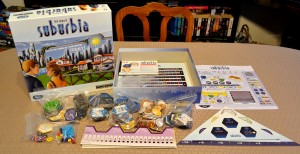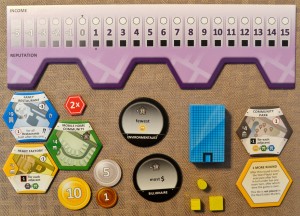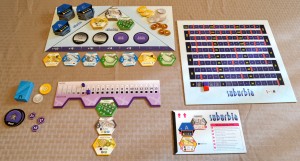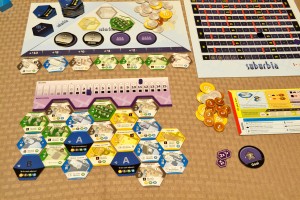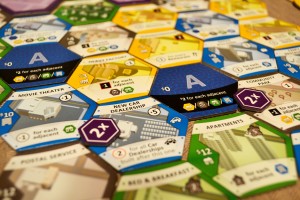The latest edition of “SimCity” for the PC was a bit of a letdown. It had a lot of great ideas, but the always online connection really rubbed me the wrong way (especially when the majority of players couldn’t even log in during launch week). I eventually resigned myself to the fact that I’d be playing “Sunrise City” for all eternity…which isn’t necessarily a bad thing. Along those lines, there’s quite the shortage of “SimCity-esque” board games out on the market, much to my surprise. It’s not like there isn’t a demand for city builders, after all. I can’t tell you how many hours I’d spend as a kid sitting in front of my SNES trying to perfect my megalopolis…I imagine that some of you can relate. Enter “Suburbia”, a tile-laying game released in 2012 that promotes a “SimCity” theme. How does it compare to “Sunrise City” and “SimCity”, you ask? Keep reading…the answers may (or may not) surprise you.
Components
Tiles – The game consists of a number of different tiles, both hexagonal and circular in shape. The latter tiles are your goal tiles, which can be both public and private. Players will be aiming to complete these goals for extra points / population at the end of the game. The hexagonal tiles come in various colors, though anyone who has played “SimCity” will recognize the green-residential, blue-commerical, and yellow-industrial themes. There’s a lot to cover here, but suffice it to say that players will be growing their individual towns by way of these hexagonal tiles.
Borough Boards, Reputation Cubes & Income Cylinders – Each player will get one borough board to help them organize the physical parameters of their town. It also tracks an individual player’s income (cylinder) and reputation (cube) via two -5 to +15 point tracks.
Population Board & Squares – This numbered track serves as the victory point counter, as well as a means to track a particular player’s total population at any one time via wooden square pieces.
Stacks Board, Supply Board & Real Estate Market Board – These three triangular boards slide next to one another to form a larger, central storage area of sorts. Tiles will be available for purchase in the real estate market, which in turn are replenished via the stacks board. The supply board simply serves as a bank, housing all of the money available in the game, those who have joy playing https://no.slotzo.com will love this game.
Investment Markers – Each player will receive three of their color, which they can use to double the effect of the tile in which they are played.
Start Player Marker – This building allows players to keep track of who started the game, just so players can have an equal number of turns when the “1 More Round” tile is flipped at the game’s end.
Setup & Gameplay
Game setup involves a number of steps (the manual lists eighteen), so I’ll instead opt to cover the hi-lites. Firstly, the three center triangular boards are set up appropriately, everything from the “A”, “B”, and “C” hexagonal stacks to the real estate market & public goals. Each player will receive a borough board, three investment markers, fifteen million in coins, two random goals, three particular starting tiles, a starting income of “0” (borough board), a starting reputation of “1” (borough board), and a starting population of “2” (population board). Players will choose one of their two secret goals to keep and discard the other. The starting player is chosen at random.
On a player’s turn, they’ll perform the following actions:
1. Buy a tile and place it OR place an investment marker on one of your existing tiles.
2. Collect or pay money (based on your income as shown on your borough board).
3. Adjust the population on your population board (based on your reputation as shown on your borough board).
4. Add a new tile to the real estate market, pushing the older tiles into the cheaper slots. Tiles are drawn from the “A”, “B”, and “C” stacks, in that order.
With the above in mind, it’s a little easier to understand the relationship between reputation vs. population and income vs. money. Essentially, the former will cause you to gain or lose the latter. Having a positive reputation or income on your borough board will affect how much of a population or money you’ll gain per turn, respectively. That begs the question…how does one gain / lose income and reputation?
Each tile you purchase from the real estate market have stipulations attached to them. Most grant or penalize income or reputation based on the tiles they are next to. Some tiles compliment each other (and thus, the player), while others will not. Placing a landfill tile next to a residential area, for example, will cause you to lose some reputation. It’s up to the player to decide how best to lay these tiles in their booming city in order to come out on top.
Players will continue building their city until the “1 More Round” tile is drawn from the “C” stack (players start from the “A” stack). After everyone has had an equal number of turns after one more complete round, the game ends and players adjust their final scores by factoring in completed goals, money left over, and so on. The player with the highest population on the population board at the end of it all, wins the game!
I admittedly left out some of the finer details (investment markers, the red lines on the population board, and etc.) to keep the review moving. For those of you wanting more information on those topics, you can find the manual on BGG here:
http://boardgamegeek.com/filepage/81149/suburbia-english-rules
The Review
The components are certainly colorful and have that “SimCity” theme about them. Residential zones like your suburbs are green, industrial zones like your heavy factories are yellow, and so on. Being an experienced “SimCity” vet, this made the game a bit easier to learn. The text on the tiles themselves, on the other hand, are a bit on the small side for my tastes. I admittedly had the most trouble with the positive and negative signs beside the numbers. Then again, I have poor eyesight, so take that complaint with a grain of salt. I do want to commend the game however for including a separate guide / reference sheet for all of the available tiles in the game…I made use of it frequently. There are also plenty of extra baggies for those of you who are like me and have OCD tendencies.
I neglected to cover the red markings on the population board, but I figured I’d quickly mention them here mainly because I feel they add significant value to how the scoring system works. Every time your population square piece crosses a red line on the population board, you lose an income and population on your borough board. Essentially, it stops runaway leaders from staying at the “15” mark and accruing mad money and population in the process. The little red marks also become more frequent the further up the population track you go, encouraging players not to expand TOO quickly. Those who do will find themselves without a lot of income, the money from which is sorely needed to buy those expensive “B” and “C” tiles in the real estate market. This makes the importance of strategically laying the tiles you buy all the more prominent
I also liked the idea that the goals are both public and private in nature. This gave me something to shoot for as opposed to just picking the most cost-effective tile on the market every single time. I was constantly trying to figure out if I should splurge on a tile that wasn’t as useful as others for the sole benefit of satisfying goals. Tiles themselves are pretty varied and have all sorts of different benefits and consequences, making it imperative that players pay attention to how they are building their town. Combined with the fact that tile price is equal to both the tile cost itself plus its position on the market tracker, players will have plenty of choices to make throughout the course of the game. The average play time of ninety minutes is fairly accurate as a result, though give yourselves an extra hour on your first run to make up for the time needed to set up, clean up, and calculate tile effects.
“Sunrise City”, despite being a city builder game itself, is a fairly different beast in terms of gameplay. Rather than trying to increase population in “Sunrise City”, you’re simply trying to earn “stars” in an efficient manner. On the other hand, there’s heavier emphasis on bidding and zoning in “Sunrise City”. Players in “Suburbia” each have their own town, whereas “Sunrise City” players contribute towards and fight over one. Role cards are absent from “Suburbia”, but public and private goals more than made up for that. “Sunrise City” has only three rounds as opposed to “Suburbia’s” fifteen to eighteen round average, but they take a bit longer to resolve. All in all, they have similar themes aesthetically, but “Suburbia” is a bit more complicated, I think. The way tiles chain their effects with one another really begin to become a headache towards the end of the game and it’s easy to miss the persistent ones. If I had to draw comparisons, “Sunrise City” would be more like “SimCity” whereas “Suburbia” is more similar to “SimCity: Societies“.
“Suburbia” is quite a treasure as far as city builder games go. There’s a lot of replay value here, as not all of the tiles and goals will be used in a single game. It’s a very deep & strategic game, but it’s not difficult to learn. The learning curve comes into play when attempting to figure out how tiles chain together and complement one another…once you get past that and how the various trackers tie together, you’re golden. The minimum age of 8+ is doable, but parental supervision would be a good idea not only to help mediate but because of the number of little pieces involved. I’d highly recommend “Suburbia” to “SimCity” fans everywhere, as well as to those who enjoy strategic tile-laying games.
Final Verdict: 10/10
—

